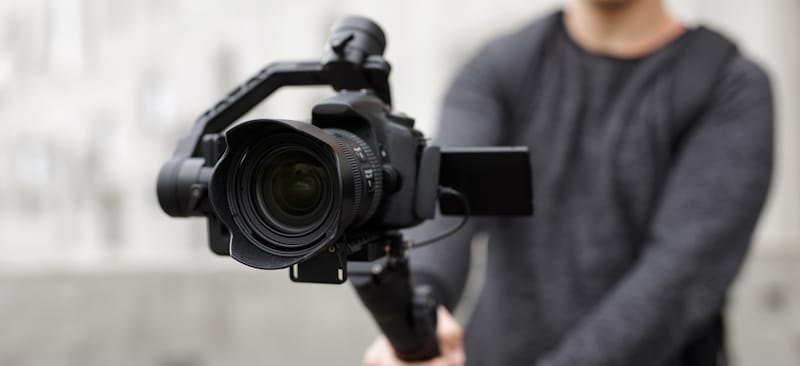To maintain perfect tracking shots through civilization, movie producers have typically used pricy and heavy equipment like dolly tracks and Steadicams. Since they were not computer-assisted, these tools require trained operators. However, recently, a brand-new device called a gimbal debuted on the market.
A gimbal is a tool that enables you to record steady, fluid video with your camera while you are moving. Two-axis and three-axis stabilization are the two most used forms. All three motions, up and down, left and right, and forward and backward, are countered by 3-axis stabilizers.
The gimbal made perfect tracking images well within reach of the low-budget director. Steadiness and motion range is essential to get the perfect shot when photographing moving objects. In this situation, a gimbal is useful.

What Is a Gimbal On A Drone
Drones are an increasingly common technology that was developed by the military and born on the battlefield. Both experts and amateur pilots can fly them rather easily. This is possible because of complex technological components that coordinate perfectly.
Drone gimbals are an essential piece of equipment for capturing those incredibly clear images and videos from several feet in the air. Gimbals are support structures that feature sophisticated motion detection technologies. They enable an object to maintain its angle while moving, most frequently a camera.
It makes use of clever sensors and calibrated electrical motors. They immediately correct for any motion the computer senses along all three axes. Gimbals for drones can be purchased separately so that a camera can be mounted or a whole unit with a built-in camera.
A drone gimbal's major mechanical components are straightforward. They consist of the camera mount and three different motors that cooperate to keep everything steady and vibration-free. Gimbals have a little more complex computing power.
The controller is a computer that resides inside the gimbal's "brain," which is a computer that converts mechanical force into an electronic signal. Before using gimbals, photographers had to hold cameras steady with their arms; otherwise, the video they captured would be unsteady.
Before the invention of gimbals, drone pilots had to concentrate on flying as steadily as possible to maintain the camera's stability. Based on how efficiently the drone could fly, there always seems to be some shaking or vibration throughout the flight, despite the pilots' best efforts to maintain the drone steady.
On the other hand, a gimbal eliminates the concern of maintaining the drone's stability while flying because it does so automatically. Without a gimbal, filming with a drone could be laborious and occasionally very discouraging when you capture a ton of footage only to discover that it is all wobbly.
If you have a gimbal attachment, you will not be concerned about the aerial shots being unsteady during editing. Your recording period will be reduced by half, allowing you to take more pictures because the footage will only be taken once from various perspectives.
What Is a Gimbal Bearing
Since the 15th century, when they were first employed to stop the movement of early compasses on ships, gimbals have existed in their current form. These days, they are used for a wide range of purposes, including holding the camera steady when recording still photos and simulating movement in motion pictures using gimbal mounts.
One of the more common uses for gimbals and gimbal bearings is marine applications. They are employed in marine applications to sustain the fragile gyro-compass and attenuate the motion of machinery located on the deck, which is likewise subject to ship motion brought on by sea conditions.
There are several applications for gimbals and gimbal bearings. The Greek philosopher Philo of Byzantium is typically credited with using them for the first time. He created an inkpot with many pen holes in 200 BC. However, no ink was spilled thanks to the usage of a collection of concentric rings.
Chinese high priests used gimbals at the end of the 1st century to hold incense pots horizontally. At the same time, they rotated around them while simultaneously utilizing them as individual body warmers to keep their garments from getting burned. As time went on, new uses emerged.
Gimbal bearings and races are unique ball bearings. One of their primary marine applications is in the drive shafts of boat engines, where gimbal technology is used to keep the bearings aligned. Gimbal bellows are used to shield the gimbal bearings against water intrusion.
Jubilee clips secure the flexible bellows to the shaft, allowing the bellows to rotate in tandem with the shaft. The link between the ship and the riser system of a drilling rig is provided by gimbal bearings. The bearings shield the machinery from excessive strain and deterioration.
What Is a Camera Gimbal
A gimbal is a hinged support that enables one-axis rotation of an object; a typical three-axis gimbal enables a camera to be put on it to move independently of the person holding the gimbal. Pitch, roll, and yaw are the three axes. The movement of a topic up and down is referred to as the pitch axis.
The yaw axis, which denotes movement from left to right, can be used to record objects moving horizontally. Additionally, objects with unleveled angles can be captured using the roll axis. These three-axis gimbals are excellent for videographers since they guarantee that a camera's movement is steady irrespective of the movement.
If you were stationary or taking a picture, a tripod would typically support and balance your camera using motors and sensors. It has numerous buttons on the handle that allow you to rotate, pan, and control your photos ranging from GoPro cameras to DSLRs and film cameras to cell phones.
How Does Gimbal Work
The gimbal can distinguish between your deliberate movements and brief, unwelcome breaks, such as shakiness. The centering motors in the gimbal, which are the same ones found in drones, ensure that this occurs and provide you with a product that appears professional. For this reason, several content producers have purchased gimbals.
A beginner gimbal might cost anywhere from $100 to $1,000, based on the type of camera you are operating. Individuals who have used a selfie stick should be familiar with the principles of using a gimbal. To prevent shaking or vibrating after you begin filming, adjust and stabilize the camera before putting on your gimbal.
Check your gimbal's battery life as well, and ensure it is completely charged before the shot. Nothing is worse than having a gimbal go off in the heart of a fantastic photo. Gimbals can be utilized to create scenarios deserving of high-end film production companies.

Gimbal Mechanism
A gimbal is a platform that pivots and enables an object to revolve along one or many axes. They are frequently used in ship navigation systems, cinematography, and photography to stabilize cameras. These applications include mounting two or more gimbals with orthogonal axes.
The perpendicular variables of elevation and azimuth form the basis for gimbal motions. Some multi-axis gimbal phases include a third axis; its movement is known as roll. The best way to visualize elevation and azimuth is to consider an object's position with the horizon.
Worm gears and stepper or servo are most frequently used with gear-driven gimbals. The ability of gear-driven systems to muffle and lessen the impact of the engine searching for a position. Direct-drive gimbals have minimal mechanical linkages in the gearbox, which results in reduced backlash.
Final Thoughts
To sum up, gimbals are a groundbreaking invention in the field of cinematography. They make it possible for budding filmmakers, particularly those working with a limited budget, to produce smooth, stable, and shakiness-free footage. Fortunately, you do not require a lot of cash or experience to produce the flawless footage you desire because now, gimbals are generally accessible.
Shawn Manaher loves to play with new toys and dive into new hobbies. As a serial entrepreneur, work definitely comes first but there is always room for hobbies.

![What Is A Gimbal: [WHEN AND WHY YOU NEED ONE?]](https://hobbynation.net/wp-content/uploads/2022/08/what-is-a-gimbal-720x405.jpg)